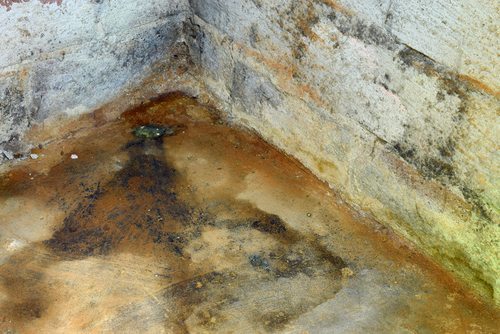As experts in foundation repair in South Carolina, we have seen how water in a basement can cause serious health and foundation problems. Your basement water leaks can be harmful to you and your family’s health and the problem needs to be addressed immediately. In this article, we will discuss what can grow in your <u>wet basement in South Carolina</u>and how a dehumidifier can help.
What Can Grow in a Wet Basement in South Carolina?
Bacteria. Bacteria love moisture. When your basement is wet from leaks and condensation issues it provides a prime breeding ground for many types of bacteria. Colonies of bacteria will be able to grow due to damp organic matter that can build up on your walls and floors. The more moisture provided the stronger the bacteria become and even the strongest anti-bacterial cleaning products may not be able to remove or kill them. This could lead to illness for family members.
Mold. The underlying public health message is that we know that people get sick from living and working in damp spaces. The things that make them sick all relate to dampness. Mold – the smell, the visibility of mold – becomes an indicator. According to the Center for Disease Control (CDC),
Inhaling or touching mold or mold spores may cause allergic reactions in sensitive individuals. Allergic responses include hay fever-type symptoms, such as sneezing, runny nose, red eyes, and skin rash (dermatitis). Allergic reactions to mold are common. They can be immediate or delayed. Molds can also cause asthma attacks in people with asthma who are allergic to mold. In addition, mold exposure can irritate the eyes, skin, nose, throat, and lungs of both mold-allergic and non-allergic people. Symptoms other than the allergic and irritant types are not commonly reported as a result of inhaling mold. Research on mold and health effects is ongoing.
The key to mold control is moisture control. If mold is a problem in your home, you should clean up the mold promptly and fix the water problem. It is important to dry water-damaged areas and items within 24-48 hours to prevent mold growth.
Mold growth, which often looks like spots, can be many different colors, and can smell musty. If you can see or smell mold, a health risk may be present. You do not need to know the type of mold growing in your home, and CDC does not recommend or perform routine sampling for molds. No matter what type of mold is present, you should remove it. Since the effect of mold on people can vary greatly, either because of the amount or type of mold, you can not rely on sampling and culturing to know your health risk. Also, good sampling for mold can be expensive, and standards for judging what is and what is not an acceptable quantity of mold have not been set. The best practice is to remove the mold and work to prevent future growth.
Pests. Pests cannot survive very long without a constant source of moisture. They also like dark places where they can scuttle away from predators. Fortunately, the ones you find in a damp basement are generally not dangerous. The most common pests found in a wet basement include:
- Silverfish. Silverfish are silver-grey creatures that can grow to one-inch and you are unlikely to spot them unless you disturb them. Capable of thriving in most climates, silverfish prefer to dwell in dark, damp areas such as basements, and are especially attracted to paper and damp clothing, which are commonly found in stored boxes.
- Centipedes. The Latin word means a hundred feet. Some have more, some have less and they come in all shapes and sizes. The body is brownish or grayish-yellow sometimes marked with three dark longitudinal stripes visible from above. A pair of long slender feelers extends forward from the head. They are carnivorous and can be controlled by monitoring moisture levels in your basement.
- Earwigs. Outdoors, you find earwigs by the dozen under any rotting tree. You will also find them in a damp basement, although you will likely need to be up at night as they are nocturnal. They scurry from cracks to feed on a variety of insects and plants. It is vital to keep rotting vegetation away from the perimeter of your home’s foundation. They will find a way to your basement and, eventually, your home.
- Sowbugs. Sowbugs are also known as woodlice or armadillo bugs because of their habit of rolling up into a ball when frightened. If it is dry outside, they may invade a damp basement in surprising numbers, although they are not serious household pests. Getting rid of them can be a challenge. Your best defense is eliminating the damp and moisture that they love.
- Dust mites. According to the American College of Allergy, Asthma, and Immunology, 50% of all respiratory illnesses are caused or aggravated by polluted indoor air. The Environmental Protection Agency (EPA) statistics show that the levels of many airborne pollutants in a basement are 2-5 times higher than the same levels outdoors. The EPA ranks basement humidity as one of the top five environmental risks to public health, and dust mite allergies are among the leading causes of these problems.
Dust mites grow and spread at an alarming rate in every household – no matter how clean it is. Dust mites can grow from eggs to adults in a single month, and they begin to reproduce after only ten days, with females laying up to 2-3 eggs each day. They live 30-100 days, with females laying as many as 270 eggs before they die. According to National Wildlife Magazine, the waste they create continuously as they live counts for 80-90% of the allergic component of house dust.Dust mite feces contains more than 15 potent allergens that sensitize and trigger allergic reactions in predisposed people. Approximately 10% of the general population and 90% of asthmatic patients are sensitive to dust mite feces allergies, and in many cases, asthma and dust mite allergies symptoms could be decreased or eliminated entirely by reducing basement moisture.
Should I Consider a Basement Dehumidifier to Control Dampness in South Carolina Basement?
A basement dehumidifier can do a couple things. First, it can remove the excess moisture in the space. As basements tend to have more humidity, there is often space where insects reside. And aside from doorways and windows, basements are often an entry point for insects and keeping this space dry goes a long way to reducing insects in your home. The dried air in the basement usually stays in the basement. Humid weather intensifies moisture problems that often cause concern in basements. Aside from health concerns, unchecked humidity levels can cause significant damage to your home.
Mechanical systems. Humidity can leave condensation on water pipes causing rust and bursting. This, of course, will lead to additional problems and costly repairs.
Flooring. Mold and mildew can get into wood flooring and carpets, and may be hard to completely remove. If the mildewed carpet cannot be cleaned with an electric shampoo machine or by a professional, replace it.
If mold develops on wood flooring, clean it with trisodium phosphate or quaternary disinfectants, then rinse and dry thoroughly. When repainting, consider a mildew-resistant paint.
Storage. Humidity can also destroy clothes, food and other stored items. Dry foods can draw in moisture and quickly go stale if humidity exceeds 60% and it is advisable to keep stored food in an air-conditioned space. Irreplaceable objects such as family photos can be destroyed with unmonitored crawl space humidity levels.
A wet basement gives mold, bacteria, and insects a safe place to live and reproduce. If not controlled, they will make their way into your home. The damage dampness can cause in your basement, aside from pests and mold, can also destroy your home’s foundation. Should you have a damp basement, call the experts at CNT


